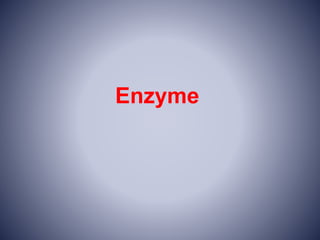
Enzyme.ppt
- 1. Enzyme
- 2. Enzyme Enzymes are proteinous substances that catalyze hundreds of stepwise reactions that - Degrade nutrient molecules, - Conserve and transform chemical energy, - Make biological macromolecules from simple precursors.
- 3. History of Enzyme - First recognized and described in the late 1700s, in studies on the digestion of meat by secretions of the stomach - In the 1850s, Louis Pasteur concluded that fermentation of sugar into alcohol by yeast is catalyzed by “ferments.” He postulated that these ferments were inseparable from the structure of living yeast cells - In 1877, German physiologist Frederick W. Kühne called these molecules enzymes. - Then in 1897 Eduard Buchner discovered that yeast extracts could ferment sugar to alcohol, proving that fermentation was promoted by molecules that continued to function when removed from cells. He named the enzyme that brought about the fermentation of sucrose “zymase”.
- 4. History of enzyme - In 1907, he received the Nobel Prize in Chemistry for his biochemical research and his discovery of cell-free fermentation". - The isolation and crystallization of urease by James Sumner in 1926 provided a breakthrough in early enzyme studies.
- 5. Properties of enzyme: - Enzymes are the most remarkable and highly specialized proteins: Enzymes, like other proteins, have molecular weights ranging from about 12,000 to more than 1 million. - Enzymes have extraordinary catalytic power, often far greater than that of synthetic or inorganic catalysts. - They have a high degree of specificity for their substrates, - They accelerate chemical reactions tremendously - They function in aqueous solutions under very mild conditions of temperature and pH.
- 6. Classification of enzymes No. Class Types of reactions catalyzed 1 Oxidoreductases Transfer of electrons (hydride ions or H atoms) 2 Transferases Group transfer reactions 3 Hydrolases Hydrolysis reactions (transfer of functional groups to water) 4 Lyases Addition of groups to double bonds, or formation of double bonds by removal of groups 5 Isomerases Transfer of groups within molecules to yield isomeric forms 6 Ligases Formation of C-C, C-S, C-O, and C-N bonds by condensation reactions coupled to ATP cleavage
- 7. How does enzyme work? Active site & substrate
- 8. Mechanisms - Lowering the activation energy - Lowering the energy of the transition state - Providing an alternative pathway. - Reducing the reaction entropy change by bringing substrates together in the correct orientation to react. - Increases in temperatures speed up reactions.
- 13. Inhibition of Enzyme 1. Reversible inhibition: a. Competitive inhibition b. Uncompetitive inhibition c. Mixed inhibition (a) (b) (c)
- 14. Inhibition of Enzyme 2. Irreversible inhibition: Inhibition of COX by aspirin
- 15. Kinetics Tests for determining Inhibition Mechanism The double-reciprocal plot offers an easy way of determining whether an enzyme inhibitor is competitive, uncompetitive, or mixed.
- 16. Kinetics Tests for determining Inhibition Mechanism
- 17. Control of enzyme activity 1. Enzyme production (transcription and translation of enzyme genes) can be enhanced or diminished by a cell in response to changes in the cell's environment. For example, antibiotics (penicillin) resistance due to beta-lactamases. Drug interaction. 2. Enzymes can be compartmentalized, with different metabolic pathways occurring in different cellular compartments. For example, fatty acids are synthesized by one set of enzymes in the cytosol, endoplasmic reticulum and the Golgi apparatus and used by a different set of enzymes as a source of energy in the mitochondrion, through beta-oxidation.
- 18. 3. Enzymes can be regulated by inhibitors and activators. Negative feedback mechanism can effectively adjust the rate of synthesis of intermediate metabolites according to the demands of the cells. 4. Enzymes can be regulated through post-transcriptional modification. For example, in the response to insulin, the phosphorylation of multiple enzymes, including glycogen synthase, helps control the synthesis or degradation of glycogen and allows the cell to respond to changes in blood sugar. 5. Some enzymes may become activated when localized to a different environment (e.g. from a reducing (cytoplasm) to an oxidizing (periplasm) environment, high pH to low pH etc.). For example, hemagglutinin in the influenza virus is activated by a conformational change caused by the acidic conditions, these occur when it is taken up inside its host cell and enters the lysosome.
- 19. Cofactor, Coenzyme: Some enzymes require no chemical groups for activity other than their amino acid residues. Others require an additional chemical component called a cofactor—either one or more inorganic ions, such as Fe+2, Mg+2, Mn+2 , or Zn+2, or a complex organic or metalloorganic molecule called a coenzyme (which are released from the enzyme's active site during the reaction). A coenzyme or metal ion that is very tightly or even covalently bound to the enzyme protein is called a prosthetic group. A complete, catalytically active enzyme together with its bound coenzyme and/or metal ions is called a holoenzyme. The protein part of such an enzyme is called the apoenzyme or apoprotein.
- 20. Cofactor Enzyme Cu+2 Fe+2 or Fe+3 K+1 Mg+2 Mn+2 Mo Zn+2 Cytochrome oxidase Cytochrome oxidase, catalase, peroxidase Pyruvate kinase Hexokinase, glucose 6- phosphatase, pyruvate kinase Arginase, ribonucleotide reductase Dinitrogenase Carbonic anhydrase,
- 21. Coenzyme Examples of chemical group transferred Dietary precursor in mammals Biocytin Coenzyme A Thiamine pyrophosphate Pyridoxal phosphate Flavin adenine dinucleotide Tetrahydrofolate CO2 Acyl group Aldehyde Amino groups Electrons One-carbon group Biotin Pantothenic acid and other compounds Thiamine (Vitamin B1) Pyridoxin (Vitamin B6) Ribaflavin (Vit B2) Folate
- 22. Enzymes and Diseases: One example is the most common type of phenylketouria. A mutation of a single amino acid in the enzyme phenylalanine hydrolase, which catalyzes the first step in the degradation of phenylalanine, results in build-up of phenylalanine and related products. This can lead to mental retardation if the disease is untreated.
- 23. Industrial Application of Enzymes: - Food processing - Baby food preparation - Brewing industry - Dairy industry - Starch industry - Paper industry - Biofuel industry - Rubber industry - Molecular biology